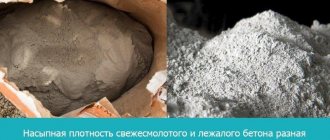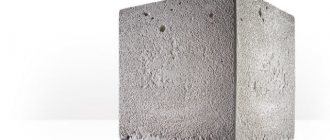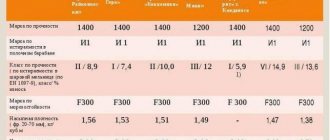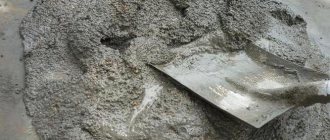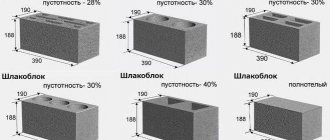Portland cement M500 grade in bags, as well as other types of binding components, are widely used in construction. Many builders pay great attention to the choice of cement and use a standard bag weighing fifty kilograms. The volume of cement in it is indicated on the packaging, which is confirmed by marking in accordance with the requirements of the standard. Beginner developers do not always know how much cement is in the bag. Having figured out the capacity of a regular bag of Portland cement, it is easy to calculate the need for cement for mixing concrete, as well as the total cost of cement.
Number of bags of cement in 1 m3 of ready-made cement mortar
By analogy with considering the question of how many bags of cement are in a cube of concrete, let’s first ask ourselves the initial data:
- Cement-sand mortar grades: M75, M100, M150, M200.
- Portland cement CEM I 32.5N PC (M400) and CEM I 42.5N PC (M500), packaged in multilayer paper bags.
- Net weight of bags: 25, 50 kg.
To determine the value - how many bags of cement are in a cube of mortar, we will use tables of proportions of concrete components in kilograms, compiled by analogy with tables of proportions of components for preparing concrete.
Table of proportions and quantities of components per 1 m3: Portland cement CEM I 32.5N PC, sand, water
| Concrete grade | Proportion, C:P:W | Cement, kg | Sand, kg | Water, l |
| M75 | 1:5:1 | 285 | 1390 | 285 |
| M100 | 1:4:0,8 | 338 | 1345 | |
| M150 | 1:2,8:0,6 | 450 | 1265 | |
| M200 | 1:2:0,5 | 560 | 1185 |
Table of proportions and quantities of components per 1 m3: Portland cement CEM I 42.5N PC, sand, water
| Concrete grade | Proportion, C:P:W | Cement, kg | Sand, kg | Water, l |
| M75 | 1:5,5:1,1 | 260 | 1405 | 285 |
| M100 | 1:4,5:0,9 | 305 | 1375 | |
| M150 | 1:3,3:0,7 | 400 | 1300 | |
| M200 | 1:2:0,5 | 495 | 1230 |
An example of calculating the value is how many bags of cement per 1 cubic meter of M200 solution based on Portland cement CEM I 42.5N PC: 495/50 = 9.9 bags weighing 50 kg; 495/25=19.8 bags weighing 25 kg.
Answers to other common questions from private developers
- How many cubes are in a 50 kg bag of cement and how many cubes are in a 25 kg bag of cement? The average specific gravity of 1 m3 of cement, accepted by all concrete plants as a value for practical calculations, is 1,300 kg/m3. Accordingly, in a 50-kilogram bag of cement: 50/1300 = 0.038 m3 of cement, and in a 25-kilogram bag: 25/1,300 = 0.019 m3 of cement.
- How many cubes of concrete can be obtained from a bag of cement weighing 50 or 25 kg? The number of cubes of concrete that can be prepared from the specified bags of cement depends on the brand of concrete. Let's consider as an example the most popular brand of concrete - M200 based on CEM I 32.5N PTs cement. To calculate using the table value of the amount of M400 cement required for the preparation of concrete grade M200 - 255 kg. We compose and solve the proportion: 50 kg x 1 m3/255 kg = 0.19 m3 and 25 kg x 1 m3/255 = 0.098 m3 of concrete, they will be 50 kg and 25 kg of a bag of M400 cement, respectively.
Similarly, using the above tabular data, you can calculate how many cubic meters of cement-sand mortar a bag of cement weighing 50 and 25 kg will be enough for.
How to calculate the amount of building mixtures to ensure the strength of the concrete composition
When calculating concrete or determining the need for material for masonry work, screeding or plastering, the procedure for performing calculation operations should be followed:
- Select the percentage according to which the cement or concrete mortar will be prepared.
- Read on the packaging how many kg of cement the bag contains.
- Convert the proportion into volume or weight units and determine the total requirement for ingredients.
- Add to the summation result the amount of water added until the desired plasticity is obtained.
Nuances of performing calculations to determine the amount of cement mixtures
During the construction process, it becomes necessary to determine how much a cube of concrete weighs.
The mass varies widely depending on the brand of concrete mixture and is:
- 1-1.8 t – for lightweight concrete mortar, marked M100;
- 1.8-2.5 t – for heavy concrete mix of grade M400;
- more than 2.5 t – for particularly heavy solutions for special purposes.
The accuracy of the calculations performed is influenced by a number of factors:
- humidity and size of feedstock;
- specific gravity of the ingredients used;
- brand of Portland cement used;
- the amount of water added during the cooking process.
Qualitatively performed calculations allow you to correctly determine the amount of raw materials required for the preparation of concrete. When using the volumetric proportion of components, it is necessary to know the actual volume of cement packed in bags. Having mastered the calculation methodology, it is easy to determine the amount of materials to prepare a strong concrete mixture.
How many tons of sand are in a cube (1 m3)? Calculator and table
Article rating: 4.9 out of 5 Votes: 10 Sand is a building material of natural origin, which is extracted from river beds, from the bottom of dry reservoirs, and in quarries. There are also artificial varieties of the material obtained by crushing and sifting hard rocks. Since the building material is particles of sedimentary and rocks, its true density depends on its origin. But in order to find out how many tons of sand are in 1 cube, this information is not enough.
Converting sand from a cube (1 m3) to tons
| 1 cube of sand | Tons |
| Construction sand | 1,5 |
| Sand builds. dry fluffy | 1,44 |
| Sand builds. dry compacted | 1,68 |
| Sand builds. wet | 1,92 |
| Sand builds. wet compacted | 2,55 |
| Molding sand | 1,71 |
| River sand | 1,63 |
| Washed river sand | 1,5 |
| Compacted river sand | 1,59 |
| Quartz sand | 1,65 |
| Dry quartz sand | 1,5 |
| Compacted quartz sand | 1,65 |
| Quarry sand | 1,5 |
| Gully sand | 1,4 |
| Mountain sand | 1,54 |
Depending on the shape, the grains of sand fit closer to each other or are located more sparsely in the total mass. The volume of air voids also affects the mass of 1 cubic meter. In this case, a hygroscopic material can absorb moisture from the surrounding air, which leads to an increase in bulk density. Specific gravity (ratio of mass to occupied volume) also depends on the amount of impurities, but in accordance with GOST 8736-2014 “Sand for construction work” standards, their volume cannot exceed 2–10%, depending on the type.
Calculation options
To find out exactly how many tons of sand are in 1 m3, laboratory tests are carried out using special measuring containers. A cylindrical vessel is filled to the brim without compacting the contents, then weighed and calculated using the formula:
p = m: V, where m is the mass of the filled container, V is the occupied volume, p is the specific gravity.
The results are recorded in a passport or quality certificate, which the supplier is obliged to provide at the buyer’s request. But at home, when the material has already been purchased, but its characteristics are unknown, similar calculations can be made. Take a 10-liter bucket, carefully fill it with sand and weigh it. If it weighs, for example, almost 17 kg, convert the resulting value into tons and substitute the data into the formula:
0.017 t: 0.01 l = 17 t/cubic. m
Remember that the bucket also has mass. For accurate calculations, it should be subtracted from the total weight. Check the obtained data with the table. They approximately correspond to the specific gravity of compacted construction sand. It is used when arranging the foundation, backfilling, paving paths, etc.
Compacted sand is on average 15% heavier than loosened sand. And wet building materials are 20–25% heavier than dry ones. If you have sand stored on your property that is not covered and has been exposed to rain repeatedly, it will be very massive. A filled 12 liter bucket will weigh at least 30 kg (0.03 tons). Accordingly, the weight of a cubic meter will be:
0.03 t: 0.012 l = 2.5 t/cubic. m
This material is not suitable for the production of building mixtures. To prepare cement mortar with it, you must first dry and loosen the sand. Otherwise, it is impossible to maintain the required proportions, and the consumption of bulk material will almost double.
Save your time and avoid complex calculations - use the calculator for converting sand from tons to m3. It is posted on the website and is available for free. Calculations are made taking into account the characteristics of bulk materials presented in our catalog. Indicate their type and origin to calculate how many tons are in a cubic meter of sand.
In our company you can buy sand with delivery throughout Moscow and the Central Federal District; to place an order, call the numbers listed on the website.
xn——elcble4adrpfe1ah.xn--p1ai
Cooperation with AlfaCem
With the group, it will become easier not only to learn about the correct preparation of compounds and how they are used to achieve optimal strength. We are ready to deliver dry powder building materials throughout Moscow and the Moscow region. All products comply with GOST and have an accompanying certificate issued in accordance with technical standards.
Leave a request or call us directly (section “Contacts”) to discuss the details of the order. A competent manager will draw up an adequate estimate, taking into account the optimal ratio of building materials. You don’t have to independently determine how much a bag of cement actually weighs. It is enough to select its type, having previously described the factors that potentially influence the future construction.
By minimizing consumption, you will save significantly, because we offer extremely competitive prices. The cost may become even lower due to discounts and bonuses. We will be grateful to every client who writes positive reviews about the company or brings constructive criticism to us. This helps to significantly improve service. Waiting for you!
Universal formula for calculating the number of cubes of cement in a bag
Due to the fact that crushing and mixing operations are used in the production of cement, the mixture of components is enriched with air, and the particles are magnetized and repelled as a result of friction. As a result, the final product in the package has a large volume of air (up to 50%). Mixing is carried out in a special tank. The mixture is removed from the container using pneumatic blowing. During storage, cement is compacted, its density is about 1600 kg/m3. The volume in the container decreases. The density of cement in a bag varies from 900 to 2000 kg/m3 depending on the degree of looseness of the mixture. It should be noted that during storage of the cement mixture, the physical state changes depending on the looseness. The density during the research turned out to be 1000 kg/m3 in a loose state. An accurate calculation of the volume of cement is necessary to determine the mixing proportions. The measuring quantity when calculating the ratio of components is volume. The volume of freshly mixed cement has the lowest density, up to 1100 kg/m3. The average specific gravity is 3 kg/m3. The density of cement during the preparation of concrete mixture varies up to 1300 kg/m3. This figure is usually taken into account when calculating the cubic volume; it is regulated by the All-Union Standards for Technological Design of Prefabricated Reinforced Concrete Enterprises (ONTP-07-85), approved by Order of the USSR Ministry of Industry and Construction No. 810 of December 20, 1985
To calculate the number of cubes of cement in one bag, a universal formula is used: Number of cubes in 1 bag, m3 = (Weight of the bag, kg)/(Average density, kg/m3) The brand of cement for preparing the solution should be taken into account. Modern manufacturers of building materials supply consumers with cement to perform various types of work.
Data on the density of the cement mixture is indicated on the packaging. The manufacturer places data on the density of bulk cement on the container, that is, taking into account air gaps. When producing concrete, it is recommended to take into account the exact ratio of the components. In this case, the amount of cement will vary depending on the type of concrete being prepared, the technology and the brand of the batch.
How many cubes in a 50 kg bag of cement
To determine the number of cubic meters in a 50 kg bag, a universal formula is used: Number of cubes in 1 bag, m3 = (50 kg)/(1300 kg/m3) = 0.038 m3 or 38 liters. The generally accepted value or the exact number on the container specified by the manufacturer is used as the density value.
How many cubes are in a 40 kg bag of cement?
To calculate how many cubes are in a 40-kilogram bag of cement, we substitute the values into the formula: Number of cubes in 1 bag, m3 = (40 kg)/(1300 kg/m3) = 0.031 m3 or 31 liters. The value generally accepted from GOST or the exact density figure indicated by the manufacturer on the packaging is used as the density value.
How many cubes are in a 25 kg bag of cement?
To determine the number of cubic meters in a 25 kg bag, a universal formula is used: Number of cubes in 1 bag, m3 = (25 kg)/(1300 kg/m3) = 0.019 m3 or 19 liters. The average value of cement density is accepted, based on regulatory documents, or the value indicated on the packaging. For example, to prepare a solution for pouring concrete into a foundation, the volume of the trench to be poured is calculated. It should be noted that the final figure for the volume of concrete will be greater, so we add another 10% to the resulting number. Using 50 kg bags of cement for mixing simplifies the calculations. To obtain 1 cubic meter of concrete you will need cement: M100 - 166 kg; M200 – 241 kg; M300 – 319 kg; M400 – 417 kg. Calculating the volume of cement in bags taking into account density will allow you to calculate the exact proportions for mixing concrete with the required characteristics.
Stamps
The final volume indicators are also affected by the grades of the material in question. The marking is based on the ability of the finished dried and established mortar to withstand the load of other materials that were used during construction.
If you find an abbreviation or letter on the package, it symbolizes the percentage of additives. The indicator indicates the load that cement can bear during operation. For example, cement M 400 will withstand the corresponding load without any problems.
M-400
Thus, marking numbers inform the buyer about performance characteristics, which take into account the durability and flexibility of materials in ready-to-use form. At the testing stage, pressure is applied to the cube, which is formed from the material discussed in the article, with the required mass.
During this process, the material begins to deteriorate. Accordingly, the final indicator is considered the desired number. In other words, cement grade M-500 will withstand the corresponding mass pressure per cm3.
M-500
How much does a bucket of potatoes weigh?
A 10-liter bucket weighs 6.5 - 7.5 kg, and a 12-liter bucket weighs up to 10.3 kg.
The weight of a bucket of potatoes, first of all, depends on the volume of the container itself. For example, 6.5 - 7.5 kg of potatoes can be poured into a 10 liter bucket. The value of this indicator is also affected by the fullness of the bucket - if the seller generously poured a heaping amount of potato tubers, then the total weight will increase.
In addition, the material from which the bucket is made is taken into account. So, in an enamel bucket, the weight of the empty container is added to the weight of the potatoes - about 2 kg
And the weight of potatoes poured into a galvanized bucket with a capacity of 10 liters will increase by about 1 kg.
About 10.3 kg of medium-sized tubers can be poured into a 12-liter bucket, excluding the weight of the container.
How much does a bucket of potatoes weigh? Another deciding factor is the size of the tubers in the bucket. More small potatoes will fit into a bucket than large ones, and the filling of the space will be more dense. But large, elongated potatoes leave a lot of free space in the bucket.
For comparison: if you pour small and large potatoes into two identical containers and compare the weight, then in the first case the bucket will be a little heavier.
Areas of use of grades of sand-cement mixtures
It is believed that a solution of a certain brand must match the rating of the building materials.
Therefore, if you use grade 100 bricks, then the binder should be of the same grade. Ultimately, the prepared solution will be homogeneous.
In this case, you should be very careful.
If any blocks are being built, grade 100 is used for this. When you need to make partition blocks from grade 25 material, then you need to make an appropriate solution. That's about a bucket of 400 rated slurry and 4000/75 rated sand, definitely taking up more space than 5 buckets.
Mass of cement in different volumetric dimensions
Usually, when preparing a concrete solution, 10 or 12 liter buckets are used to measure the components. Cement is measured not only in kilograms. In some cases, it is necessary to quickly calculate its cubic capacity and displacement for one regular 50 kg bag.
Volume of cement in a bag
Cement is a rather loose and inert material. And its density can change over time. If it is not possible to determine the density of the material, then take the average number of 1300 kg/m³, which is approved by ONTP 07-85. This indicator means that one cube holds 13 kg of binder material.
A visual on the calculation of cement in the video below:
Accordingly, we make further calculations: 13001000 = 1.3 liters. For a 50 kg bag: 501.3 = 38.5 l. By analogy, calculations can be made for a 25-kilogram bag. It holds 31 liters of cement with the same bulk density value.
Cubic capacity of cement in bag
The volume of a 50 kg bag of cement in cubes is an equally important indicator, which cannot be avoided when calculating the required amount of binding material and its transportation. To find out how many cubes there are in a 50 kg bag of cement, you must first calculate how much volume 1 kg of cement has. For this, you need: 1/1300 = 0.000769 m³. Accordingly, we make a calculation for a 50-kilogram bag: 50 * 0.000769 = 0.038462 m³. Using this analogy, you can quickly recalculate for any volume.
It clearly shows what volume of binder in bags is needed to prepare standard grades of concreteSource decor-b.ru
It is worth keeping in mind that the volume of concrete components is greater than the volume of the finished solution, and when recalculated, the output may result in a smaller volume of cement used. This indicator will affect the cost of production and the profitability of the entire production as a whole. Always take into account the percentage of loss of binder that remains on the mixer blades, is sprayed into the air when mixing components, or spills out when dosing carelessly.
The more closely the particles adhere to each other, the higher the density of the material. Therefore, when dosing, it is not recommended to tamp or shake it. If the material is stale, to increase its bulk density, it is recommended to dose it into the bunker from a height of 1 - 2 meters.
Watch the video for a simple calculation of cement per 1 cubic meter:
How to prepare a solution at sub-zero temperatures?
At -5 degrees there is no need to add additives. In colder conditions, it is necessary to use special products, because the seams may simply crumble. It is also worth taking the main components seriously. For example, difficulties arise with frozen sand.
To prevent this from happening, you need to do it in advance. It can also be placed in a room with a warm temperature regime. The water should be warm or hot. With it, the solution will not freeze.
In addition, the detergent dissolves much better at warm temperatures. In the winter season, you also need to take into account the fact that you need to add anti-corrosion agents.
The specific gravity of cement is a certain indicator of its density and depends on the brand of cement. It is determined by the ingredients of the solution used and the purpose of their use.
Briefly about the main thing
The volume of cement in a 50 kg bag is no less important an indicator for any builder or production worker than its tempering strength. Knowing how many buckets, liters and cubes of cement are in a standard 50-kg bag, you can accurately determine its volume for purchase and transportation to the site. Dosing the binder in buckets when preparing concrete greatly simplifies and speeds up the process of its preparation.
Such values are determined by simple calculations. To produce them, you need to know the bulk density of cement, which is indicated in the attached passport, or take the average established value - 1300 kg/m³. It can also be determined experimentally in a laboratory setting or with the necessary devices and tools.
The average value is that a bag weighing 50 kg holds approximately 3.5 ten-liter buckets of cement.
Tools for work
- Mixing container - a pallet or concrete mixer, a large rectangular bowl (trough). It is best to choose a concrete mixer, since the pallet is difficult to work with, and individual components can collect in a container with corners.
- Shovel - for laying components.
- Bucket - used as a measuring container when determining the volume of components.
- A construction mixer or drill for mixing the composition (if you are preparing a little).
- Construction cone - can be useful for determining the level of mobility of the mixture.
- Tools for performing work - rules, trowels, spatulas, etc., the set depends on the task.
How much does a bucket of cement weigh?
How much does a bucket of cement weigh?
- The bulk density of cement is about 1250-1300 kilograms per 1 cubic meter. The volume of the bucket is 10-12 liters, let's assume that we have a 10-liter bucket, the weight of cement in a full bucket will be about 13 kilograms, the bucket weighs about a kilogram, it turns out that a 10-liter bucket of cement will weigh 13-14 kilograms.
- To find out the weight of a bucket of cement, you must first decide on the brand of cement, because no matter how outwardly cement of different brands may look similar to each other, they still differ in density and in extreme cases this difference is very noticeable. Portland cement is considered the lightest, but it is also the most common and cheapest among its analogues. The weight of a bucket of Portland cement, depending on the brand, will be from 10 to 15 kilograms. Portland slag cement weighs approximately the same - 11-12.5 kilograms. Another common brand of cement that hardens in water, alumina cement weighs 10-13 kilograms in a loosened state, and the same cement GC 400-600 in a compacted state weighs 16-19 kilograms in a 10-liter bucket.
- To find out the weight of cement in a bucket, you need to multiply the volume of the bucket in liters by the bulk density of the cement. Each bucket has its own volume, and the bulk density of cement is 1200 - 1300 grams per liter. So make calculations from these data.
- An average bucket of cement will weigh about 12-13 kilograms. This is if we take into account the standard 10 liter bucket, which can often be found at construction sites. Now the construction season is underway and the question will be relevant.
- What kind of cement are we talking about, do you need dry cement or a ready-made mortar? The finished weight depends on its components and density. And in dry it depends on the size of the bucket. In general, a 10-12 liter bucket weighs 15 kilograms.
- In general, the average weight of a bucket of cement is about twelve kilograms. I wouldn’t say that it’s not enough, but in principle it’s not that much. Although it depends on what kind of construction work you need cement. You will need a lot of it to fill the foundation!
- In order to find out the amount of cement in kg in one bucket, you must first find out what the density of the cement is. And the density of cement is 1200 g per cubic centimeter.
Now you need to decide on the volume of the bucket. The bucket can have a volume of 7, 10, 12, 15 and 20 liters (that is, cubic centimeters).Now you need to multiply 1200 by the volume of the bucket and divide the resulting figure by 1000.
Usually a 10 liter bucket is used.
1200 * 10 / 1000 = 12 kg of cement in one 10 liter bucket.
- If we consider that the average bulk density of cement is 1200 kg/cm, and the volume of a bucket in liters is 10 kg, then we can easily calculate the weight of a bucket of cement.
To do this, we need to multiply the density of cement by the volume of the bucket in liters.As a result, we get the weight of a full bucket of cement.
- Experience shows that one fifty kilogram bag of cement can be poured into 4 buckets with a volume of 8 liters. From here it is easy to calculate that an eight-liter bucket of cement weighs approximately 12.5 kilograms.
- It is not clear why there is such a need to know the weight of a bucket of cement. Why do you need this? After all, mortars are prepared not by weight, but by proportions. To find out its weight, you just need to weigh it. But I’ll tell you as a builder, its weight is about twelve - twelve and a half kg.
info-4all.ru
The process of preparing the required solution
One of the available subtypes of mortars is used - these are plaster and masonry types, which have some differences between each other. The substance must not contain foreign impurities such as roots, stones, grass or clay.
In order to increase the strength of the solution, you need to add appropriate plasticizers to it.
Plasticizer
The solution must be mixed in a large container. Initially, water is taken and poured there, then lime, and then thoroughly stirred to obtain a special milk of lime. Then a certain amount of sand is added. You can also prepare a solution using dry and astringent material.
Its dry ingredients need to be mixed and water gradually poured into it.
In order to prepare the solution, you need to remember the ratio of the binder filler and the proportions of sand. Solutions that are suitable for plastering. Sand, which should mainly be fine-grained and clean, should include a number of other impurities not exceeding 5%.
From the sand into which clay is taken in production and added at low consumption, a solution of plastic structure emerges. It is more convenient to carry out construction with it, but after it dries it becomes covered with cracks.
Preparation of the solution
For the characteristic indicators of durability and safety of the plaster in its original state, the main role will be played by the granularity. Excessively fine sand requires more binding material to be added to it.
Over time, the solution will become “greasy” and this will lead to the appearance of cracks. They increase the water resistance of the outer layer of plaster. In order to carry out interior plastering work on a house, a lime substance made from special lime (air) is used.
The most popular ratio of such a mixture is one to three. This type of solution sets without any problems.
Its grains should be no more than 1.2 mm. Remember that per meter of sand you will need from 120 to 200 kg of material. This is especially true when it comes to a room with a lot of moisture inside. The amount of cement in a cement-lime mortar depends on the purpose of the mortar.
Cement-lime mortar
As a rule, it is used for external plastering. It can also be used for interior plastering, for example, on staircases. To finish the walls and ceilings of staircases, take 60 kg of cement per 140 kg of lime.
Plastering walls
To plaster staircases you will need 100 kg of cement per 140 kg of lime.
Mass of a cube of concrete
The mass of concrete is one of its characteristics. This indicator allows you to give a qualitative assessment of the physical and mechanical properties and composition. If the design maintains the parameters of durability and strength, then the use of lighter solutions significantly reduces the cost of construction not only due to the cost of raw materials, but also by reducing the cost of its transportation.
Materials
To prepare 1 cube of concrete you will need:
- Cement (accuracy 1 kg);
- Crushed stone (accuracy 5 kg);
- Water (50% of cement volume);
- Sand.
75% of the volume is aggregate. The weight of 1m3 of lightweight concrete can vary from 500 to 1,800 kg. The weight of heavy trains is about 1,800-3,500 kg. The calculations are based on the figure 2,300-2,500 kg. According to standards, the mass of components differs depending on the brand.
The specific gravity of the material shows how much one cube of concrete weighs. It is customary to divide it into 4 types:
1. Particularly light.
Cellular with a large number of pores, constituting up to 85% of the total volume. Cell size – up to 1.5 mm. Used in thermal insulation.
2. Lightweight.
Contains porous aggregates (expanded clay) and 600 g of sand. Used as ready-made blocks.
3. Heavy.
Considered a classic. Contains coarse filler. The range of destinations is very wide.
4. Extra heavy.
With large aggregates such as barite, hematite or magnetite. Often used as radiation protection at nuclear power plants.
The table shows some consumption rates per 1 cubic meter:
| brand | crushed stone, kg | sand, kg | cement, brand, kg | water, m3 |
| M100 | 1 440 | 870 | M300, 214 | 0,21 |
| M150 | 1 440 | 855 | M400, 235 | 0,21 |
| M200 | 1 440 | 795 | M400, 286 | 0,21 |
Specific gravity
The volumetric weight of a cube of concrete is directly proportional to its strength and grade:
| types | stamps | specific gravity, kg | fillers |
| especially light | M50 - M75 | up to 500 | porous (perlite, vermiculite) |
| lungs | M100 - M200 | 500-1800 | expanded clay, tuff, pumice |
| heavy | M200 – M400 | 1800-2500 | high-density rocks (quartz, limestone, crushed granite) |
| especially heavy | M 450 and above | 2500-3000 | heavy materials (iron ore, cast iron shot) |
The table shows the masses of cubic meters of compositions depending on the types:
| View | kg/m3 |
| Shungizite | 100-1 400 |
| Vermiculite | 300-800 |
| Foam silicate and gas silicate | 300-1 000 |
| On expanded clay sand | 500-1 800 |
| Perlite | 600-1 200 |
| On perlite sand | 800-1 000 |
| On quartz sand | 800-1 200 |
| Gazozol and penozol | 800-1 200 |
| Pumice concrete | 800-1 600 |
| On volcanic slag | 800-1 600 |
| On ash gravel | 1 000-1 400 |
| Aggloporite concrete on fuel (boiler) slags | 1 000-1 800 |
| on granulated blast furnace slag | 1 200-1 800 |
| on gravel or crushed stone | 2 400 |
| Reinforced concrete | 2 500 |
Application
The areas of application of grade 500 cement are quite extensive due to its special properties. Here is a list of the most popular:
- construction of major highways;
- hydroelectric power stations;
- underground military bunkers;
- airfields;
- aviation runways;
- construction of bridges;
Construction of bridges
- during the construction of prefabricated facilities, pouring formwork;
- reinforced concrete residential buildings;
- large shopping and gaming centers;
- underground garages;
- Metro stations;
- External finishing attributes in the form of monolithic figured fences.
It would take a long time to list possible structures where grade 500 cement sand is used.
How to calculate how many buckets of cement are in a 50 kg bag
Having information at hand opens up an undeniable advantage for the master - the ability to easily and quickly calculate proportions during concrete preparation. In addition, this is an excellent opportunity to easily calculate how much cement is contained in a bag and convert the volume into buckets.
Features of cement packaging
Traditionally, cement is packaged in multilayer paper bags (bags) with a capacity of 50 kg. But focusing on the solvency of the population and the needs of customers, 90% of companies began to produce packages weighing 20, 25, 35, 42, 46 kilograms.
Therefore, taking into account the above, a person can easily get confused with the choice of packaging of the required packaging, and this threatens to cause problems with preparing the solution. Therefore, before purchasing, check how many buckets of cement are in a 50 kg bag, if it is more convenient to select the proportion.
As mentioned, traditional packaging in 50 kg bags is the most convenient and common. This is the optimal packaging for manual loading work. Therefore, it is more profitable to purchase dry material in this form. For work, you can choose a product from any manufacturer with the necessary technical characteristics.
How to calculate how much material is in a bucket?
Fresh cement is a loose dry mixture consisting of dust microparticles and microscopic air inclusions that fill the voids between them.
In a loosened state, cement is characterized by an average density of 110-1600 kg/m3. This parameter determines the percentage of dry mixture in the prepared solutions, which ultimately affects the strength and speed of concrete hardening. The density of the substance depends on how many buckets of cement are in a 50 kg bag.
How to measure material in liters?
Please note that the density indicator must be indicated on the packaging. To simplify calculations, the density of cement is taken to be approximately an average value of 1190 kg/m3. This means that in a standard paper bag (50 kg) the volume of material is 42 liters
This means that in a standard paper bag (50 kg) the volume of material is 42 liters.
From here we calculate how many buckets of cement are in a 50 kg bag. For packaging in half a quintal, the volumes given in the table below are valid.
| Bucket capacity (l) | Number of cement buckets in a bag 50 kg |
| 10 | 4,2 |
| 12 | 3,5 |
| 16 | 2,6 |
When preparing concrete mortar, it is more convenient to use containers than to take measurements (weighing) and struggle with proportions. Therefore, knowing how many buckets are in a 50 kg bag of cement, you can prepare the solution faster and with better quality.
Neither domestic nor industrial construction is complete without the use of concrete mortar. The basis for the production of concrete is a cement mixture consisting of a number of components. In the process of mixing bulk material from bags, sand, gravel or fine crushed stone and water, concrete is obtained. It is prepared depending on the need and scope of application and used only for its intended purpose.
An example of calculating material in buckets for 1 bag (50 kg)
Let's take a 35 kg bag. According to the formula, we divide the weight of the package by the density: 35: 1.19 = 29.4 liters - that is, almost three ten-liter buckets. Accordingly, if you take a 20 kg bag, the volume will be 16.8 liters - one full sixteen-liter bucket of cement.
Important! Please note that the proportions are rounded down, since the finished solution does not contain air, and the volume of cement in liters depends on the density of the dry material and is calculated using the formula
It is better to purchase cement with an average density (1190 kg/m3), and when purchasing, pay attention to the date of manufacture. The compacted material has a higher density (1500-1600 kg/m3), and lower quality characteristics, which is why there is a significant consumption of material. Now you know how many buckets are in a bag of cement and how to calculate the volume of cement in buckets when going to a hardware store
The ability to calculate the volume of material allows you to save on the purchase of material. After all, you don’t risk spending money on bags of mixture, which in the end will turn out to be superfluous and will stand until it petrifies
Now you know how many buckets are in a bag of cement and how to calculate the volume of cement in buckets when going to a hardware store. The ability to calculate the volume of material allows you to save on the purchase of material. After all, you don’t risk spending money on bags of mixture, which in the end will turn out to be superfluous and will stand until it petrifies.
Varieties
This cement brand is also divided into several types:
- with the presence of additional impurities and additives, but not more than 20%;
- complete absence of additives in the dry mixture. Such building material is designated D0.
Without additives
There is a big difference between these two types, and therefore they are used in certain types of buildings. First of all, this is the composition of cement.
M500 d0 cement is made from the purest clinker and contains a small proportion of gypsum, which is why the mortar made from this building material sets much faster than its competitors. If this particular cement marking is present in the concrete, then the finished structure will last a significant period.
Cement sand with additives is inferior in characteristics to sand without additives. And although the setting time is the same, due to the presence of additional components it is not used for the construction of monolithic structures, therefore the cost of cement m500 d20 is slightly lower than d0.
But it is good to use when finishing external facades of buildings, screeding floors, laying bricks and pouring foundations. This material is less susceptible to corrosion.
Floor screed
The use of this brand guarantees high strength of the finished structure and can withstand significant pressure. Perfect for office buildings.
The M500 cement range includes the following compositions:
Portland cement;
Portland cement M500
with the presence of additives that increase resistance to sulfate. Allows the use of the solution even in aggressive conditions;
M500 with additives
with the presence of plasticizers that increase the rate of hardening.
With plasticizer

